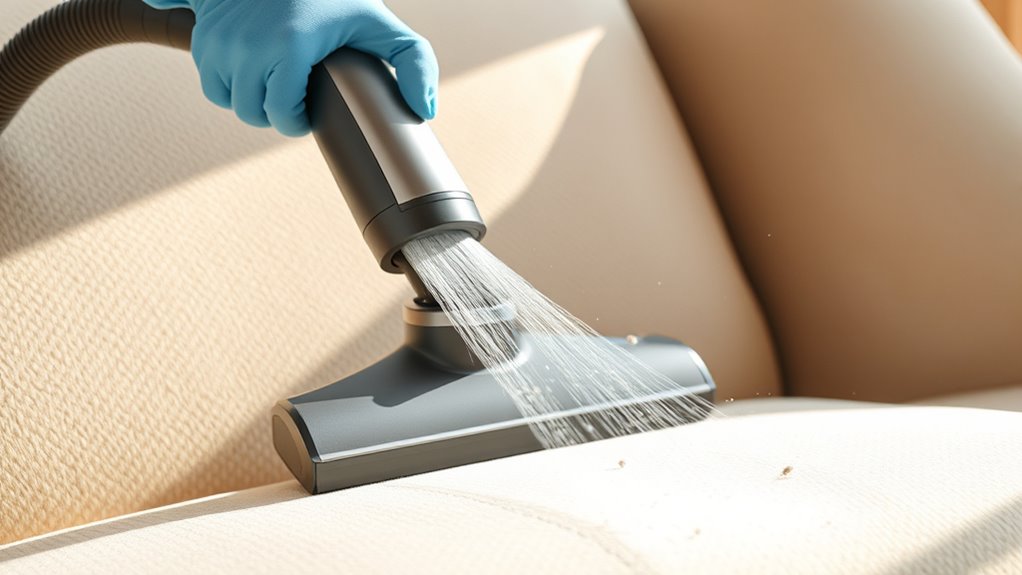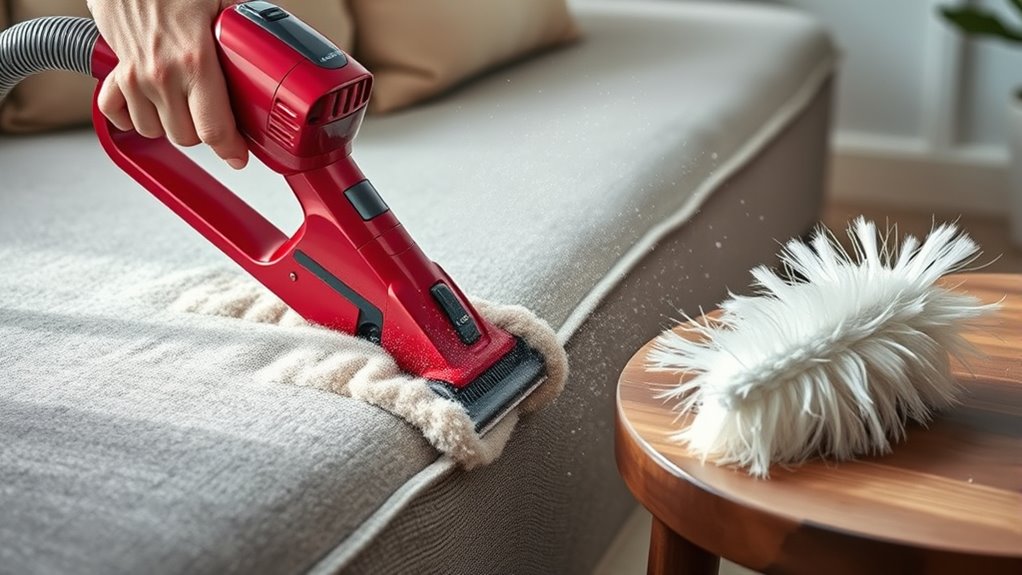To reduce dust mites and support your respiratory health, vacuum regularly with a HEPA filter at least twice a week, focusing on carpets, upholstery, and curtains. Use damp cloths or microfiber dusters instead of dry dusting to trap allergens effectively. Wash bedding weekly in hot water and use allergen-proof covers on pillows and mattresses. Keeping indoor humidity below 50% also makes your environment less hospitable to dust mites. Discover more simple steps to breathe easier as you go along.
Key Takeaways
- Vacuum carpets, upholstery, and curtains at least twice weekly using a HEPA filter vacuum to trap dust mite allergens effectively.
- Use a damp microfiber cloth for dusting surfaces to prevent stirring up dust mites and allergens.
- Wash bedding weekly in hot water (at least 130°F/54°C) and use allergen-proof covers on pillows and mattresses.
- Maintain indoor humidity below 50% with dehumidifiers or air conditioning to inhibit dust mite growth.
- Regularly clean or replace vacuum filters to ensure optimal allergen removal and indoor air quality.

Dust mites are tiny creatures that thrive in your home’s bedding, furniture, and carpets, often triggering allergies and asthma. The good news is that you can considerably reduce their presence by focusing on allergen control and maintaining proper bedding hygiene. Regular vacuuming and dusting are your first lines of defense, helping to remove dust mite allergens from surfaces where they commonly hide. Using a vacuum cleaner equipped with a HEPA filter is essential because it traps microscopic particles, preventing them from being recirculated into the air. As you vacuum, pay special attention to carpets, upholstered furniture, and curtains, since these areas tend to harbor the most dust mites. Aim to vacuum at least twice a week, ensuring you cover every corner and crevice, and don’t forget to replace or clean the vacuum filter regularly to maintain peak efficiency.
Regular vacuuming with a HEPA filter twice a week helps reduce dust mite allergens effectively.
Dusting also plays a vital role in allergen control. Use a damp cloth or microfiber duster to wipe down surfaces, which helps trap dust and prevents it from becoming airborne. Avoid dry dusting, as it can stir up dust mites and their allergens, making respiratory issues worse. Focus on areas where dust tends to settle, such as shelves, baseboards, and window sills. Regularly cleaning these surfaces reduces the overall dust load in your home, which is essential for managing allergy symptoms and preventing asthma triggers.
Bedding hygiene is especially important because bedding is a prime habitat for dust mites. You should wash your sheets, pillowcases, and blankets weekly in hot water—at least 130°F (54°C)—to kill dust mites and remove allergens. Consider using allergen-proof covers on pillows and mattresses, which create a barrier against dust mites and their allergens. If you’re sensitive, replacing old bedding and pillows periodically can also help minimize allergen accumulation. Additionally, keeping humidity levels below 50% makes your environment less hospitable to dust mites, so using a dehumidifier or air conditioner can be beneficial. Maintaining proper humidity levels is a key factor in controlling dust mite populations and improving indoor air quality.
Incorporating these practices into your routine can dramatically improve your indoor air quality. Regular vacuuming, dusting with damp cloths, and diligent bedding hygiene work together to control allergens and reduce dust mite populations. By staying consistent with these habits, you create a healthier living space that’s less likely to trigger allergies or asthma attacks, giving you relief and peace of mind at home.
Frequently Asked Questions
How Often Should I Replace My Vacuum Cleaner Filters?
You should replace your vacuum filter every 3 to 6 months, depending on its vacuum filter lifespan. Regularly replacing filters guarantees peak suction and helps reduce dust mites, improving your respiratory health. Check the manufacturer’s instructions for specific guidance, as some filters need more frequent replacing, especially if you have allergies or pets. By replacing your vacuum filters on time, you keep your vacuum working efficiently and maintain a healthier home environment.
Are Natural Cleaning Products Better for Dust Mite Reduction?
Imagine someone switching to natural cleaning products, like vinegar and baking soda, and noticing fewer allergy symptoms. Natural ingredients are generally better for dust mite reduction because they avoid harsh chemicals that can irritate your respiratory system. Plus, they promote chemical safety in your home. These products often target dust mites more gently, making your environment healthier and easier to maintain without risking chemical exposure.
Can Air Purifiers Help Reduce Dust Mites?
Air purifiers can help reduce dust mite allergens by improving air quality and capturing tiny particles. Their effectiveness depends on the filter type, with HEPA filters being most efficient at trapping allergens. While they don’t eliminate dust mites directly, air purifiers considerably lessen airborne dust mite allergens, making your environment healthier. Use them alongside regular cleaning for the best results in managing dust mite-related respiratory issues.
Do Dust Mite Covers Prevent Them Completely?
Think of dust mite covers as shields for your bedding, but they don’t make you invincible. While dust mite covers are effective in reducing exposure by preventing mites from burrowing into mattresses and pillows, they won’t eliminate every mite or allergen. The effectiveness of covers depends on proper use and quality. Combining covers with regular cleaning and air filtration is your best bet for a healthier, allergy-free space.
What’s the Best Way to Clean Bedding for Dust Mite Control?
To effectively clean your bedding for dust mite control, wash your bed linen weekly in hot water at least 130°F (54°C). Use high-quality bedding encasements to trap dust mites and prevent their spread. Regularly remove and wash comforters, pillowcases, and sheets, and consider replacing old bedding. These steps reduce dust mite populations, helping you breathe easier and improve respiratory health.
Conclusion
By regularly vacuuming and dusting, you’re taking control of your environment, much like a gardener tending to delicate plants. Just as careful pruning keeps growth healthy, these simple actions protect your respiratory health from unseen invaders. Remember, each small effort is a step toward a fresher, cleaner space—your personal sanctuary. Embrace these habits, and you’ll find that, like a well-tended garden, your home can flourish with robustness and comfort.









